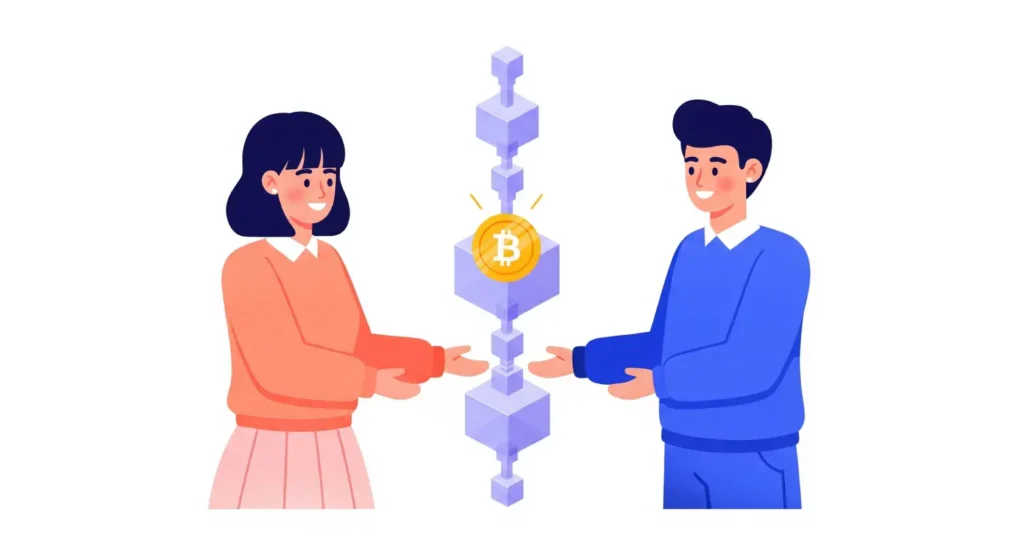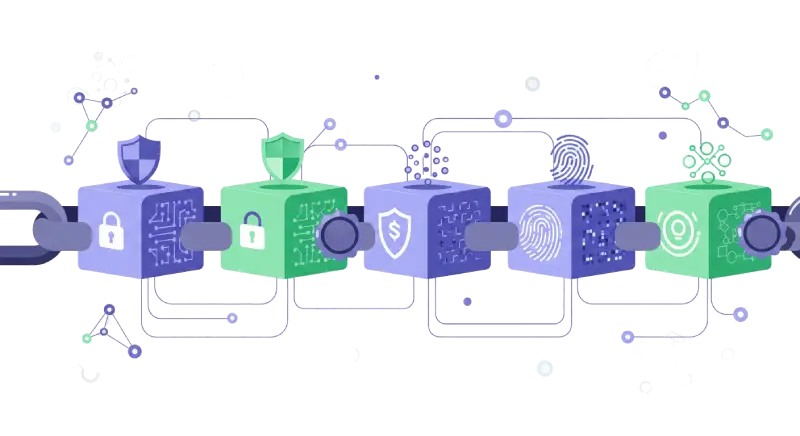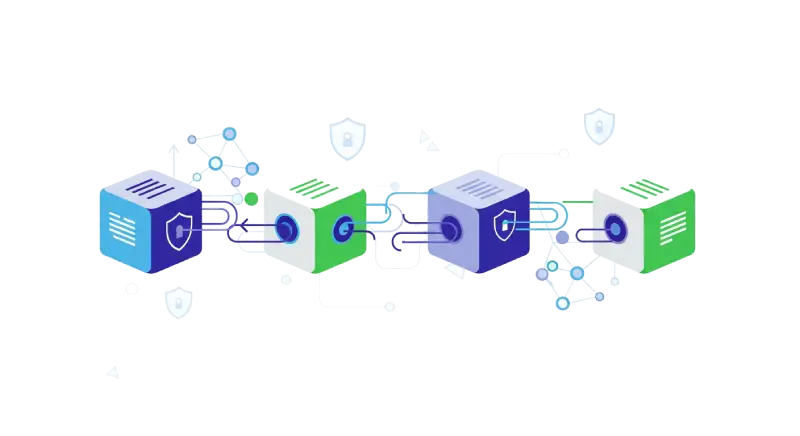
Want to understand how blockchain works without a bank? This guide helps you master the blockchain transaction process by following Alice sending 1 Bitcoin (BTC) to Bob. We’ll break it down into 6 clear steps with easy analogies, like a shared notebook, to make it understandable.
Why should you care? Blockchain is a way to record transactions, like a digital diary everyone can see but nobody can change. It powers Bitcoin and other cryptocurrencies. This simple blockchain transaction guide uses examples to show how it works for beginners.
No tech background? No problem! We’ll explain terms like “hash” (think fingerprint) or “mining” (like solving a puzzle) in a way anyone can get. By the end, you’ll know how Alice’s payment becomes part of Bitcoin’s unchangeable chain, mastering the blockchain transaction process.
Ready to dive in? Let’s explore the 6 steps to understand blockchain transactions! 🚀
📌 Key Takeaways
Before we jump into the steps, here’s what you’ll learn about Bitcoin’s blockchain. This simple blockchain transaction guide sums up the big ideas in plain English to help you master the blockchain transaction process.
- ✅ Blockchain is like a shared Google Sheet: It’s a digital record everyone sees, but nobody can change, keeping transactions safe.
- ✅ Payments are signed with secret codes: Alice uses a special key to prove her payment to Bob is real.
- ✅ Payments wait in a line: They sit in a “waiting room” (mempool) until picked for a block.
- ✅ Miners solve puzzles: They bundle payments into a block by cracking a math challenge.
- ✅ Puzzles stay balanced: The network tweaks the challenge so new blocks come every 10 minutes.
- ✅ Blocks are locked forever: Everyone checks and adds blocks to the chain, making them unchangeable.
Let’s get to the steps of this blockchain transaction process! 🚀
1. Making a Payment
This step, called creating a transaction, starts the blockchain transaction process. Alice sends 1 Bitcoin (BTC) to Bob, like writing a digital check only she can sign. Here are the key actions for beginners.
- Create a digital record: Alice’s wallet builds a transaction, listing inputs (where her BTC comes from), outputs (Bob’s address), and the amount (1 BTC).
- Assign a unique ID: The transaction gets a TXID, like a tracking number, to identify it on the blockchain. It is a unique code (hash) of its data, created automatically, used to track it on explorers like Blockchain.com.
- Sign with a private key: Alice uses her private key, like a unique signature, to prove she’s sending the money.
- Set Bob’s address: Bob’s public key is converted into an address, like an email for money, directing the BTC to him.
- Verify sufficient funds: The wallet checks Alice’s balance to ensure she has enough BTC for the transaction.
With the transaction created, it’s ready to enter the Bitcoin network! 💸
2. Sending the Payment to Everyone
This step, called broadcasting, sends Alice’s payment to Bitcoin’s network, like shouting a message to a crowd that spreads it further.
- Send to network nodes: Alice’s wallet transmits the transaction to Bitcoin’s nodes—computers run by volunteers, enthusiasts, or organizations like miners or exchanges.
- Validate by nodes: Nodes check the transaction’s format and signature to confirm it’s legitimate and not a duplicate.
- Store in the mempool: Valid transactions wait in a mempool, like a queue at a coffee shop, until miners select them.
- Add fees for priority: Alice can include a small fee, like a tip, sized based on network congestion (busier network, higher fee), to encourage miners to pick her transaction faster.
- Handle disagreements: If some nodes reject the transaction (e.g., due to errors), others that accept it keep spreading it until it’s included in a block.
Now Alice’s transaction is in the mempool, ready to be grouped into a block! 🖥️
3. Grouping Payments into a Page
This step, called building a block, adds Alice’s payment to Bitcoin’s blockchain, like a librarian organizing notes into a page of a shared notebook.
- Select transactions: Miners choose payments, like Alice’s 1 BTC to Bob, from the mempool, prioritizing those with higher fees for better rewards.
- Build a Merkle Tree: Miners create a Merkle Tree, like an organized list, combining all transactions into a single code to save space and speed up verification.
- Add a block header: The header includes a link to the previous block, a timestamp, and metadata, like a title page for the notebook.
- Include a coinbase transaction: Miners add a special transaction to pay themselves a reward (new BTC plus fees).
- Respect block size limits: Blocks are capped at about 1 MB, so miners select transactions carefully to fit.
This block, like a page in the shared Google Sheet, is now ready to be locked into the blockchain! 📚
4. Solving a Puzzle to Lock the Page
This step, called Proof of Work, locks Alice’s block, like securing a page in Bitcoin’s notebook. Miners solve a math puzzle to make it unchangeable.
- Find a nonce: Miners test billions of random numbers, called a nonce, like trying different keys to find one that fits a lock, combining it with block data to create a hash, to secure the block.
- Generate a valid hash: The nonce and block data create a hash, a unique code that must start with specific zeros, set by the network’s difficulty.
- Share the winning block: The first miner to find the right nonce broadcasts the locked block, and others verify it.
- Ensure security: The puzzle’s high difficulty makes tampering costly, protecting the blockchain transaction process.
- Earn block rewards: Solving the puzzle grants miners new BTC and transaction fees, motivating their work. For details, see the Bitcoin Whitepaper.
With the block locked, it’s ready to join the blockchain! 🔐
5. Keeping the Puzzle Just Right
This step, called adjusting difficulty, ensures new blocks are added every 10 minutes. It balances the puzzle’s challenge in the blockchain transaction process. Here are the key actions.
- Set the difficulty level: Difficulty defines how hard it is to find a valid hash, like a bullseye that requires a specific number of zeros at the start of the hash.
- Update every 2016 blocks: Every two weeks, Bitcoin checks block creation time and adjusts difficulty to maintain a 10-minute pace.
- Account for hashrate: Hashrate, the total computing power of all miners (like the speed of their puzzle-solving), affects adjustments—more power increases difficulty, less reduces it.
- Maintain stability: This keeps blocks predictable, ensuring the blockchain transaction process is reliable for users like Alice and Bob.
- Prevent network issues: Difficulty adjustments avoid delays or congestion, keeping the blockchain efficient.
With the difficulty set, the block is ready to join the chain! ⚖️
6. Checking and Adding the Page Forever
This step, called validation and chaining, adds the locked block to Bitcoin’s blockchain, ensuring it’s correct and unchangeable.
- Validate the entire block: Nodes—computers run by volunteers—check the block’s hash, transactions, and rules, unlike Step 2 where they checked only individual transactions.
- Add to the blockchain: If valid, the block links to the previous block via its hash, like gluing a page into the notebook. Bob gets his 1 BTC.
- Follow the longest chain: Nodes agree on the longest chain of blocks, ensuring a unified blockchain transaction process.
- Confirm with more blocks: Later blocks (confirmations) make Alice’s transaction harder to reverse.
- Prevent tampering: Changing a block’s hash breaks all following blocks, making tampering obvious to nodes.
- Reach consensus: Nodes work voluntarily, without payment, to agree on the chain, ensuring its reliability.
Alice’s payment is now part of the blockchain forever! Let’s answer some common questions next. 🔗
7. Frequently Asked Questions – Blockchain Transaction Process
Got questions about blockchain and Bitcoin? This section answers them in a way anyone can understand. Let’s clear up confusion with a blockchain transaction process approach. 🔍
Q1 What is a blockchain?
A: It’s a digital ledger shared across many computers, recording transactions like Alice’s 1 BTC to Bob. Nobody can change it, thanks to math-based locks called hashes. It’s a shared record everyone trusts. Learn more in What is Blockchain. 🔗
Q2 How does Bitcoin stay secure?
A: Transactions use secret codes (private keys) to prove they’re real. Miners solve hard puzzles to lock blocks, and nodes check everything. Changing a block breaks the chain, so cheating is hard. Explore secure blockchain payments in What Makes Blockchain Secure. 🔒
Q3 What is mining?
A: Mining is when computers solve math puzzles to add blocks to the blockchain. It’s like clerks securing pages in a ledger. Miners get rewards, like fees or new BTC. It’s a key part of the blockchain transaction process. ⛏️
Q4 Why does mining use so much energy?
A: Solving puzzles takes lots of computer power, like running many machines nonstop. This makes Bitcoin secure but uses electricity. Some blockchains, like Ethereum, try less energy-hungry methods. It’s a trade-off for security. ⚡️
Q5 How does Bitcoin’s blockchain differ from traditional banking?
A: Bitcoin’s blockchain is a shared ledger run by many computers, not a single bank. Transactions, like Alice’s payment, are checked by nodes, not bank staff. It skips middlemen, lowering fees, but relies on miners for security. 💸
Q6 What’s the difference between Bitcoin and other blockchains?
A: Bitcoin uses Proof of Work (puzzles) to add blocks. Others, like Ethereum, might use Proof of Stake, like voting instead of puzzling. They all store transactions but work differently. Learn about Ethereum in What is DeFi. 🌐
Q7 Can the blockchain be hacked?
A: It’s very hard because every computer (node) checks the chain. A hacker would need to control most nodes, which is costly and rare (called a 51% attack). The chain’s math ensures secure blockchain payments. That’s why Bitcoin’s trusted. 🛡️
Q8 What mistakes should beginners avoid in the blockchain transaction process?
A: Newbies often send BTC to the wrong address, which is irreversible—always double-check the recipient’s address. Setting fees too low can delay your transaction in the mempool. Also, never share your private key, as it’s like giving away your bank password. 📝
Got more questions? Drop them in the comments on our Telegram channel. 📝
🎯 Conclusion
You’ve followed Alice sending 1 Bitcoin (BTC) to Bob through 6 steps! This blockchain transaction process guide showed how Bitcoin’s blockchain works, from creating a payment to locking it in a notebook. Here’s what to know next.
- Blockchain is transparent: Transactions, like Alice’s payment, are stored, verified by a network of computers. This makes Bitcoin reliable without banks.
- Bitcoin has trade-offs: Mining uses significant energy, and there’s a small risk of network attacks (like a 51% attack). These push innovation in other blockchains, like Ethereum.
- Blockchain isn’t just for Bitcoin: It powers DeFi, NFTs, and Layer 2 solutions like Lightning Network, opening new possibilities.
- Get hands-on experience: Download a Bitcoin wallet (like Electrum or BlueWallet) to try sending payments yourself. It’s a simple way to explore the blockchain transaction process without running a server. Check out How to Get Started with Crypto for tips.
This blockchain transactions explained journey makes crypto less mysterious. Share your thoughts in the comments on our Telegram channel and keep exploring! 🚀

